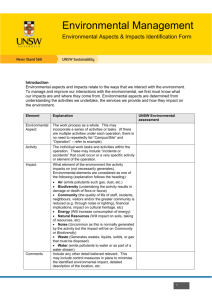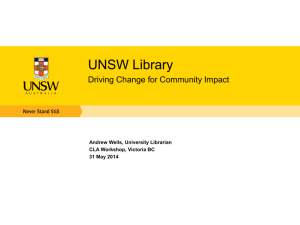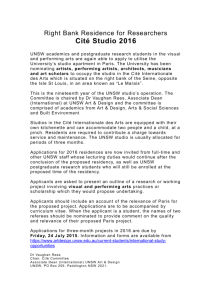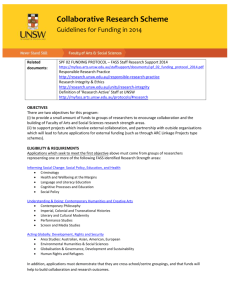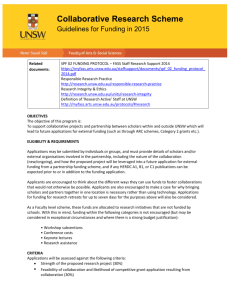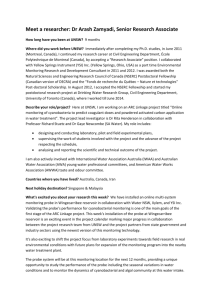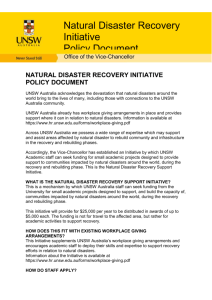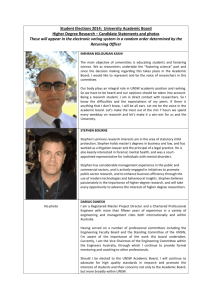Sustainable Architecture
advertisement
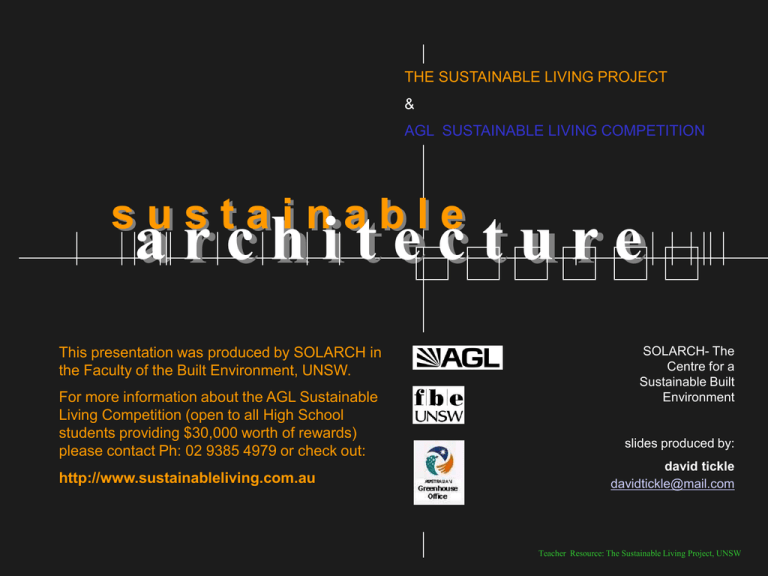
THE SUSTAINABLE LIVING PROJECT & AGL SUSTAINABLE LIVING COMPETITION sustainable architecture This presentation was produced by SOLARCH in the Faculty of the Built Environment, UNSW. For more information about the AGL Sustainable Living Competition (open to all High School students providing $30,000 worth of rewards) please contact Ph: 02 9385 4979 or check out: http://www.sustainableliving.com.au SOLARCH- The Centre for a Sustainable Built Environment slides produced by: david tickle davidtickle@mail.com Teacher Resource: The Sustainable Living Project, UNSW architecture sustainable architecture Teacher Resource: The Sustainable Living Project, UNSW roof and walls allow privacy, protect from rain and wind, and stop intruders windows allow sunlight and fresh air to enter the building and allow views outside a sense of place (within a community) kitchen has clean drinking water what do buildings provide ? outdoor space for recreation and relaxation kitchen for cooking and storing food table for gatherings and for eating food bathroom for washing and cleaning and for sewage removal Images: COLORS magazine, issue 27 ‘home’ raised floor keeps things dry and clean (not on ground) interior lighting and heating couch for relaxing and talking Teacher Resource: The Sustainable Living Project, UNSW things provided by buildings light and warmth energy clean water bathing and cleaning energy supply water supply waste disposal protection from rain and cold waste and water disposal privacy and security storage, cooking and eating of food all of these factors inter-relate and should be seen as contributing to and feeding from the others building materials socialising and recreation Teacher Resource: The Sustainable Living Project, UNSW the natural environment sustainable architecture Teacher Resource: The Sustainable Living Project, UNSW A FEW BASIC TRUTHS: As a result of neglecting to consider the environmental consequences of our actions, we now find many serious environmental problems emerging. • WE NEED A CLEAN ENVIRONMENT FOR OUR SURVIVAL • EVERYTHING IS INTERDEPENDENT AND INTERRELATED Traditionally, decisions and designs have been based on economics, form and function. The broader environmental context – in which all things exist, and on which all things rely- has not adequately been considered. ‘resources’ soil technology knowledge oceans water culture forests we are part of the environment, and not separate from it society biodiversity If we want to have ecological resources to use in the future, and ensure a high quality of life, we must start considering the broader environmental context in our designs and choices. the natural environment Teacher Resource: The Sustainable Living Project, UNSW In most cases, it is not our ‘needs’ relating to the built environment that cause environmental problems – rather it is the way we choose to meet them. Where do present materials come from? waste and water disposal water supply building materials energy supply Images: National Geographic, Vol 195, No 3, March 1999; Oz Green World Water Day Poster, 1997; “Greenhouse News”, Vol 3, Issue No 2, Winter 2000, published by the Australian Greenhouse Office; “The Challenge”, Issue No 16, Winter 2000, published by the Australian Greenhouse Office How much do we currently use? Teacher Resource: The Sustainable Living Project, UNSW what are the impacts of unsustainable design & building practices ? INCREASED AIR POLLUTION chemicals and gases PRODUCTION OF WASTE rubbish, materials, chemicals, etc UNNECESSARYD ELEPLETION OF NATURAL RESOURCES forests, water, minerals, soil EFFECTS ON PUBLIC HEALTH we all need clean air and water, good food GREENHOUSE GAS EMISSIONS global warming and climate change INCREASED WATER POLLUTION raw sewage rubbish chemicals sustainable architecture looks to find new ways to provide our needs without creating these impacts INCREASED SOIL CONTAMINATION chemicals, dirty water, loss of nutrients Teacher Resource: The Sustainable Living Project, UNSW technology the design process sustainable architecture people sustainability Teacher Resource: The Sustainable Living Project, UNSW ecologically sustainable development: accommodating the needs of the present without compromising the ability of future generations to meet their own needs (Brundtland Report, World Commission on Environment and Development 1987) appropriate technology: making and using technology that meets human needs while taking into account long and short term consequences for society and the environment sustainable design process: 1. understand the needs of the users of the building 2. look at the capacity of the site and the environment in supporting those needs 3. make design decisions and use appropriate technologies to fulfil the above Teacher Resource: The Sustainable Living Project, UNSW using an environmentally conscious design process to achieve sustainable results case studies sustainable architecture Teacher Resource: The Sustainable Living Project, UNSW water collected from roofs Materials • include natural materials such as timber, marble and copper • create a warm and pleasing environment (social benefits) • are locally produced, therefore reduce transportation pollution and resources NMB Bank Headquarters, Amsterdam Rainwater • is collected from the roof natural breezes (reduces mains water consumption) Hello!! • used for water features and to water plants inside the building (creates a cool, healthy and pleasing environment) water fall Windows • allow natural sunlight into the building (less electricity used for lighting) • can be opened to allow cross-ventilation (building has no airconditioning, and uses much less electricity) Staircases designed to be appealing, in order to: • reduce reliance on lifts (reduces electricity consumption) • allow for interaction between co-workers (social benefits) • create an architectural feature Images: “Green Design”, Dorothy Teacher Resource: The Sustainable Mackenzie, (1991), London: LaurenceLiving King Project, UNSW Publishing
